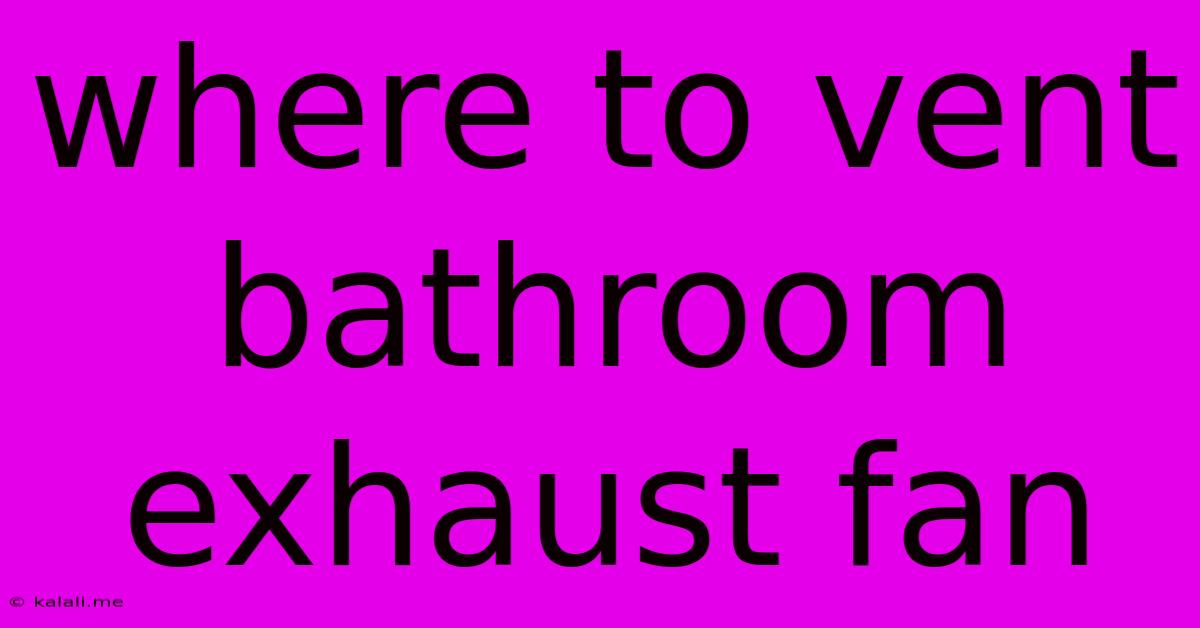Where To Vent Bathroom Exhaust Fan
Kalali
May 30, 2025 · 3 min read

Table of Contents
Where to Vent a Bathroom Exhaust Fan: A Comprehensive Guide
Meta Description: Learn the best practices for venting your bathroom exhaust fan to prevent moisture damage, mold growth, and ensure optimal performance. This guide covers various venting options and crucial considerations.
Proper bathroom exhaust fan ventilation is crucial for maintaining a healthy and comfortable bathroom environment. Failing to vent your fan correctly can lead to moisture buildup, mold growth, musty odors, and even structural damage. This comprehensive guide will walk you through the best practices for venting your bathroom exhaust fan, ensuring a healthy and efficient bathroom.
Understanding the Importance of Proper Venting
Bathroom exhaust fans are designed to remove excess moisture and humidity generated during showers and baths. This moisture, if left to accumulate, can create a breeding ground for mold and mildew, leading to respiratory problems and structural damage to your home. Proper venting ensures this moisture is expelled outside, preventing these issues. Key benefits of proper venting include:
- Preventing Mold and Mildew: This is perhaps the most significant benefit. Mold and mildew thrive in damp environments, and a properly vented exhaust fan eliminates this condition.
- Reducing Musty Odors: Excess moisture contributes to unpleasant odors. Effective venting keeps your bathroom smelling fresh.
- Protecting Your Home's Structure: Constant moisture can damage walls, ceilings, and even the structural integrity of your home. Proper ventilation prevents this.
- Improving Indoor Air Quality: By removing excess moisture and pollutants, a properly vented exhaust fan contributes to better indoor air quality.
Choosing the Right Vent Location
The ideal location for your bathroom exhaust fan vent is directly to the exterior of your home. This ensures the moist air is expelled quickly and efficiently. Here are some factors to consider:
- Shortest Route: The vent should follow the shortest possible route to the outside. Longer ducts increase the risk of blockages and reduce fan efficiency.
- Avoid Low Points: The vent line should slope slightly upwards to prevent water from accumulating within the ductwork.
- Accessibility: Choose a location that allows for easy access to the vent for cleaning and maintenance.
- Local Building Codes: Always check your local building codes and regulations for specific requirements regarding exhaust fan venting.
Different Venting Methods
Several methods exist for venting your bathroom exhaust fan:
- Through the Roof: This is a common method, particularly for bathrooms located on upper floors. It involves running the vent duct through the attic and out through the roof.
- Through the Wall: This is often the preferred method for bathrooms located on exterior walls. It's typically simpler and less expensive than roof venting.
- Through the soffit: This method is sometimes used for bathrooms located on the upper floor but involves routing the duct through the attic and then out through the soffit.
Important Considerations:
- Duct Material: Use rigid, non-flexible ductwork for optimal airflow. Flexible ductwork can easily collapse, restricting airflow and reducing fan efficiency.
- Duct Size: Ensure the duct size matches the fan's specifications for optimal performance. A duct that is too small will restrict airflow.
- Backdrafting: Proper venting prevents backdrafting, where outside air is drawn into the bathroom. This can lead to reduced fan efficiency and energy loss.
- Regular Cleaning: Regularly clean the vent and ductwork to prevent blockages and maintain optimal airflow.
Troubleshooting Common Venting Problems
- Weak Airflow: This may indicate a blockage in the ductwork or a problem with the fan itself.
- Musty Odors: This could signify inadequate venting or mold growth within the ductwork.
- Water Leaks: A leak near the vent suggests a problem with the installation or sealing of the vent.
By following these guidelines and considering the factors mentioned above, you can ensure your bathroom exhaust fan is vented properly, creating a healthier, more comfortable, and efficient bathroom environment. Remember to consult a qualified professional if you are unsure about any aspect of the installation or if you encounter any problems.
Latest Posts
Latest Posts
-
How To Remove Sticky Residue From Wood
May 31, 2025
-
What Is The Difference Between Bake And Convection Bake
May 31, 2025
-
Fallout 4 Cant Place Molecular Beam Emitter
May 31, 2025
-
How Did Doflamingo Get Aces Devil Fruit
May 31, 2025
-
Manhua About A Guy That Gets Trained By The Gods
May 31, 2025
Related Post
Thank you for visiting our website which covers about Where To Vent Bathroom Exhaust Fan . We hope the information provided has been useful to you. Feel free to contact us if you have any questions or need further assistance. See you next time and don't miss to bookmark.